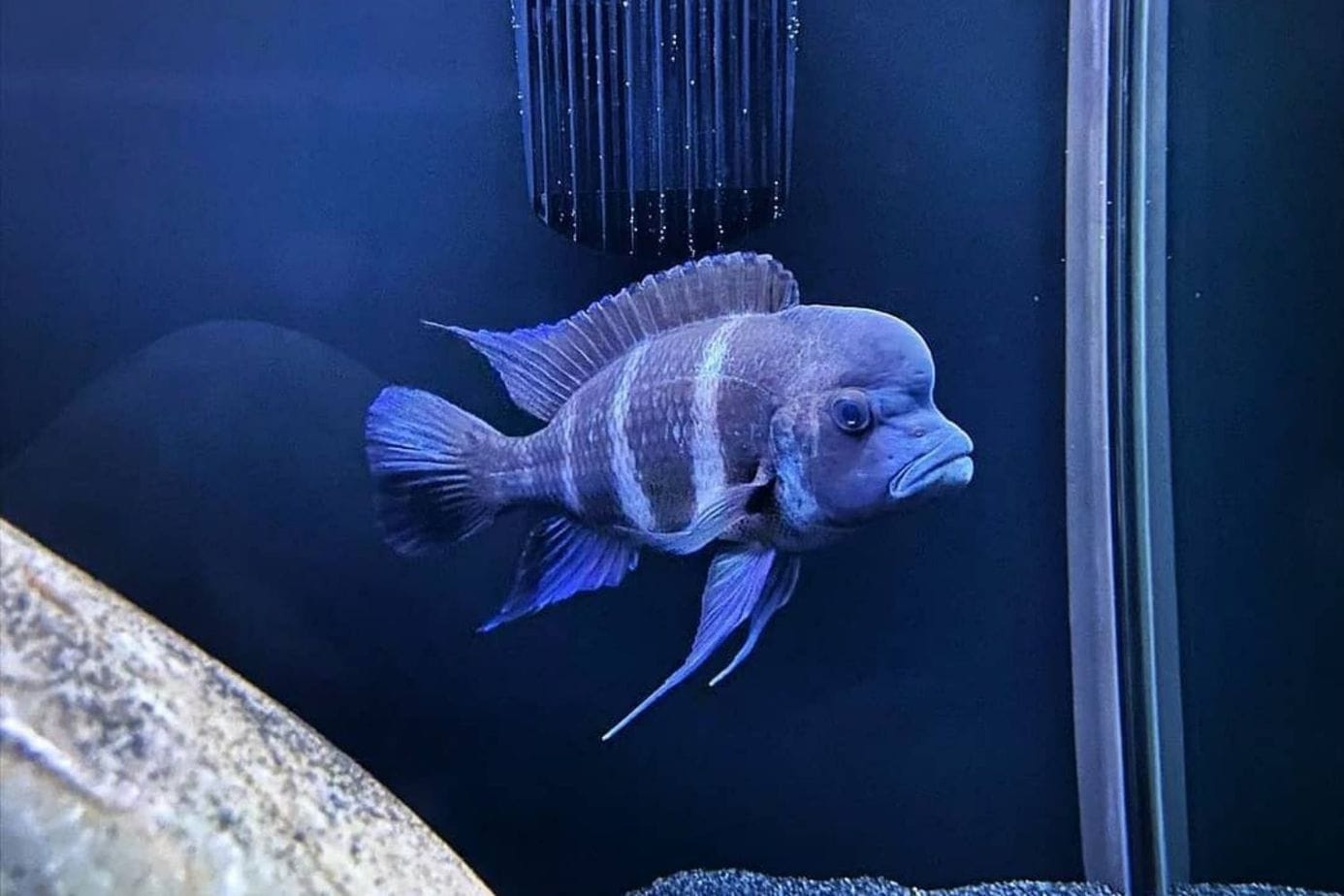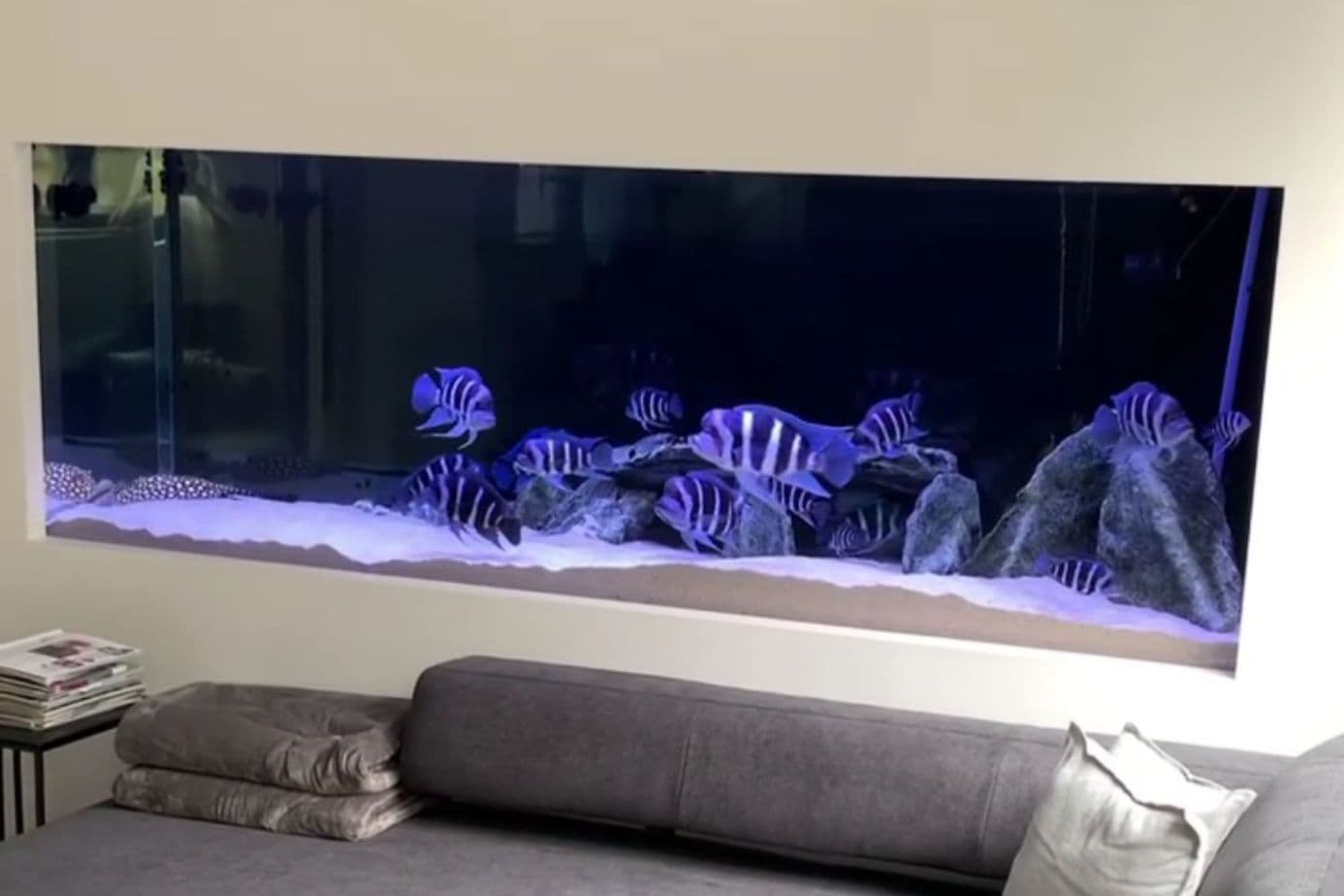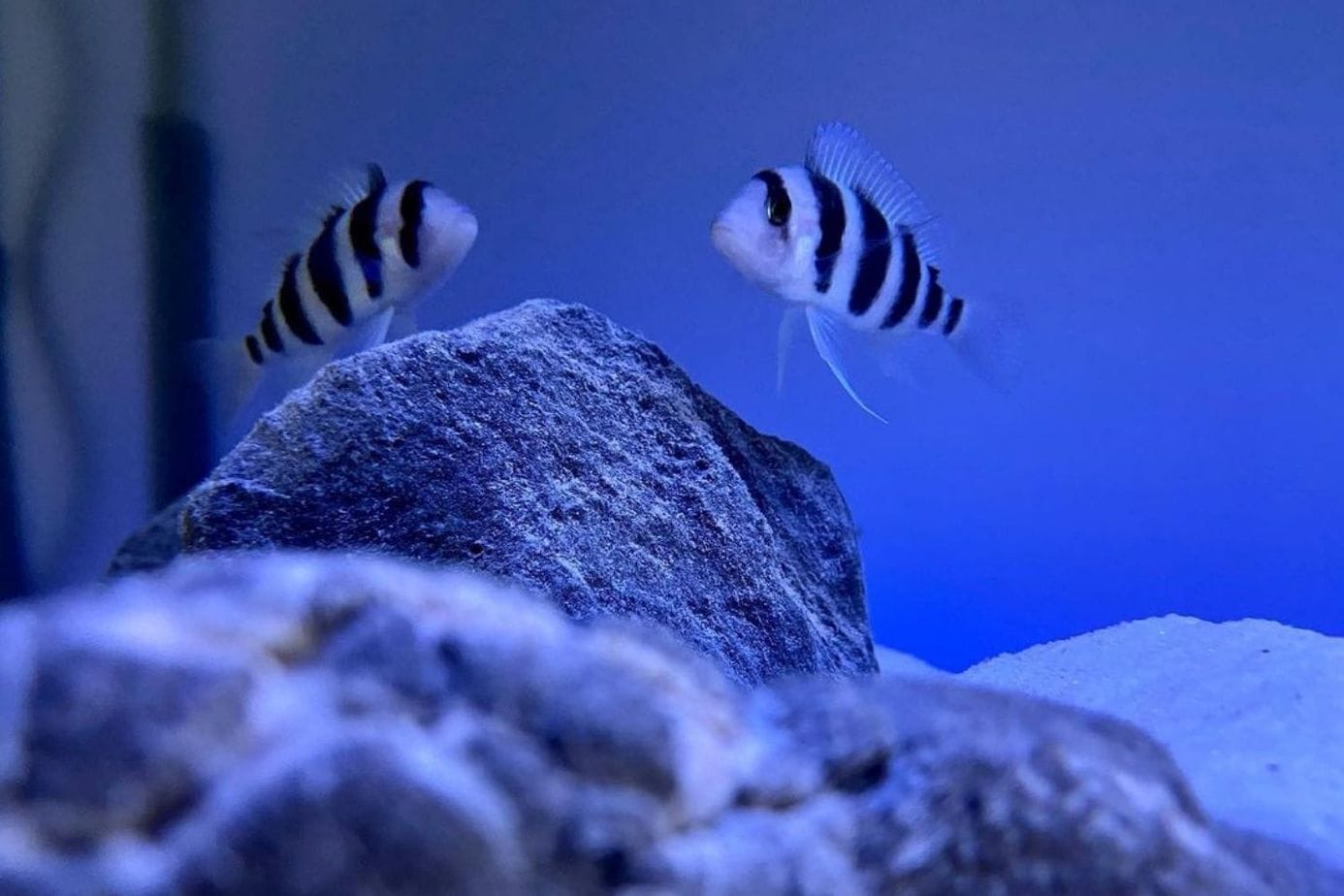In this article, you will find everything you need to know about Frontosa cichlid. This amazing fish will win your heart with its vibrant coloration. It is one of the stunning cichlids that will enchant your freshwater aquarium and hypnotize you with its variety.
You don’t have to worry about research if you are looking forward to keeping this fish. We have plenty of experience with cichlids and have done all the research for this fish to finally come up with the complete Care Guide for this fish. If you are a beginner, you also have a tank setup guide to start with.
Overview
Frontosa Cichlid is also known by its scientific name Cyphotilapia Frontosa, which also can be found with the name Frontosa Burundi. This amazing fish is native to Lake Tanganyika. It is a semi-aggressive fish, but quite calm and not very active swimmer. Frontosa tank size is 75 gallons per specimen. 125 to 150 gallons are needed for 4 to 6 adult fish. They require space as they are a little bit territorial, especially during the breeding period.

A closer look of Frontosa Cichlid. Can you spot his amazing colors?
They have an amazing appearance, a black body with white stripes and a vibrant blue reflection on the fins. When they are stressed, they get darker in color, and when happy, their vibrant coloration shows up. In coloration, they are quite similar to aggressive Electric Blue Ram Cichlid.
| Care difficulty | Moderate |
| Temperament | Semi-aggressive |
| Color Form | Black, blue, white |
| Diet | Carnivore |
| Max Size | 8” – 12” (20 cm – 30 cm) |
| Temperature | 72-80 °F (22 – 22 °C) |
| pH | 8.0-9.0 |
| GH | 10 – 18 dGH |
| Tank Size | 75 Gallons min |
| Lifespan | 10 to 15 years |
Behavior & Temperament
This fish is semi-aggressive but is very calm compared with the Jaguar cichlid or Wolf cichlid. It is recommended to keep 6 to 8 together in order to reduce aggression. It requires less flow rate, as it is not an active swimmer. They conserve their energy until feeding time or picking on other fish in the breeding season. These guys are ambush predatory. They lay and wait for the prey to pass by, and then they attack them and kill them.
Size & Lifespan
This fish grows quite large in size. 8 to 12 inches is their max size. The purchase size is about 1.5” to 2.5”. They live up to 10 years in general. If kept with a good diet and high maintenance for a healthy life, they will live up to 15 years.
Red Frontosa Cichlid
The Red Frontosa cichlid is line-bred from Taiwan, one of the Frontosa species. The lack of organization in the species’ DNA caused the fish to get reddish-brown vertical stripes instead of the common black ones, white bodies, and blue hoes. This fish differs from other Frontosa fish not only in color but also has a lifespan of up to 25 years.
Blue Zaire Frontosa
This type of Frontosa will definitely dominate your tank display. This handsome cichlid is absolutely stunning and will win your heart. It has a rich, bold pattern. White or blue background with 6 or 7 black bands, and occasionally a nice gold reflection in the dorsal fin. It is one of the bluest varieties of Frontosas, and it has a deep blue, almost purple coloration.

Blue Zaire Frontosa has a stunning look.
Origin
Frontosa Cichlid is an endemic fish that can only be found in Lake Tanganyika. There are various types of this fish distributed all over the lake. This fish lives in the deep waters of this lake, up to 60m deep, hiding in caves, but the commonly Frontosa that we know lives shallow up to 5m. In their natural habitat, they are not territorial as they have a lot of space and like to live in large colonies.
Diet: How to Feed Frontosa
This fish lives at the bottom of the tank, and most Frontosa will only eat sinking food. They are carnivores and require a high-protein diet. But they also can be fed with pellets and flakes; keep that in mind when choosing the best Cichlid food. In case you would feed them with pellets or flakes, an automatic fish feeder would be an essential tool to feed these fellows. This would also save time if you are busy and grow your fish healthy without needing to follow its feeding frequency.
Here are some foods that would be perfect for this fish’s diet:
- Bloodworms
- Frozen brine shrimps, Mysis shrimp, as well
- Krill shrimp, freeze or dried
- Fish pieces
- Other High-protein food
They have predatory behavior and love live food. You can spoil them from time to time with it, but not too many, as it can make a mess, and this fish is sensitive to poor water conditions.
Be careful with bloodworms, as they can cause the boul inflammation and float to the surface. Several small feedings a day is way better than one large meal.

Feeding time for our small group of Frontosa Cichlid.
Frontosa Cichlid Care & Tank Setup
This fish is very sensitive to water conditions. The water should be clear and changed from 10% to 20% per week. If the nitrite and ammonia levels are high, even more frequent water changes are needed. The water in the tank should match the conditions of the water in the wild.

Frontosa Cichlid requires a big aquarium. We have attached the aquarium to the wall.
This fish is quite large and will swim in almost all the areas of the tank. A Frontosa tank should be at least 125 gallons for a small group of Frontosa. The water should not make drastic changes, as it can hurt the fish. It is also good to add one tablespoon of salt per 11 gallons. The salt, in this case, is used as a buffering agent; this will increase the carbonate hardness and will help the function of the thyroid, which will increase the Frontosa cichlid growth rate.
The substrate is important for this fish. Sand or small-sized gravel would be perfect, and saltwater sand would be the ideal choice for keeping up the pH levels. Crushed corals are an alternative option. It is important to provide enough swimming space for the fish.
Objects such as caves or rocks are needed for this fish to hide. Juveniles, females, and other fish sharing the same tank might feel stressed from male Frontosa’s aggressive behavior, and the object will be the perfect place to hide.
Here are some basic steps of Frontosa tank setup:
- Rinse the tank and other equipment. It is important to rinse the tank before you start setting up. Make sure there is no dust or debris.
- Glue the accessories. Put the tank on the side carefully and start gluing the objects.
- Put the substrate. Put the sand or gravel on your tank
- Install the equipment. You should take your time to install the equipment such as filter, heater, etc.
- Fill the tank. Fill the tank halfway with room temp water. Make sure not to stir the sand or gravel.
- Put the objects. It is time to put all the objects where the fish will hide, driftwood, branches, pots, live rocks, or whatever else.
- Prime the filter. The filter should be primed in the water.
- Plug the heater. Plugin the heater 10 min later.
- Put in the Frontosa. IMPORTANT!!! Wait at least 48 hours for the aquarium to run. Then you can add the fish.
Water Parameters
The water parameters are very important for Frontosa cichlids. They are quite sensitive and will get sick or even die in poor water conditions. The temperature should range from 72 to 80 degrees Fahrenheit, pH of 8.0 – 9.0, and water hardness of 10 – 18 dGH.
They need clear water, and so you should pay attention to a very good filtration system, strong and efficient to keep the water clear. The water should be oxygen-rich, and bubbles should run day and night for Frontosa fish to grow happy and healthy.
Breeding: Sexing Frontosa
Frontosa Cichlid is quite a difficult cichlid to breed. It is best to keep 6 to 8 fish in order to pair naturally. The ideal group during the breeding period would be one male with several females. They are best kept in a 150 gallons tank, and 200 gallons or larger tank would be great for the long term. The young Frontosa needs 3 to 4 years to be sexually mature and start breeding.
The Frontosa females usually spawn their eggs in caves in the wild. While breeding in captivity, they will lay up to 100 eggs on the substrate. Clay pots and rocks would be great during the breeding period to help reduce the stress of the female while mating. The female will lay the eggs (an average of 50 eggs) between the rocks or other objects, and the male will fertilize them.

After a successful breading we got 2 new Frontosa cichlid.
The female tends to pick up the fertilized eggs in their mouth, which we call mouth-brooding, and they will hatch in 3 days. The female has amazing parental skills and will keep the fries in her mouth for 4 to 6 weeks. The best food for the fry is live brine shrimp.
Sex Difference
This amazing fish is hard to sex, although there are some differences in between. The males usually have the biggest hump on the head. The females have rounder bodies slightly and more rounded sex organs. The male has a more triangle-shaped one. As for the behavior. The males are more aggressive and tend to pick on females during the breeding period.
Diseases
Frontosa Cichlid is as sensitive to various common diseases as other fish. They are most susceptible to the famous Ich. This disease is commonly caused by protozoa, and it has various symptoms such as twitching, rubbing their bodies on objects, and white spots on the body. It is not difficult to heal, and the fish responds well to the medications.
Skin flukes and other parasites are common problems in this fish. It can be infected by them and experience as well as fungal infections and bacterial infections. In these cases, it is best to remove the sick fish into another tank with no plants or substrate. Use the right medications, and do not forget to remove the filtration pump since it can absorb the medication.
If one of your fish is sick, you’ll never know if the disease is transmitted to other fish. In this case, it is good to investigate and take care of other fish as well. Slightly increase the tank temperatures for about three days and maintain high-quality water.
Tank Mates
This fish is semi-aggressive, although it can have a lot of tankmates, thanks to its peaceful nature and friendly behavior. The ideal community life for this fish is one male and 4 to 5 females. It is optional to keep in other groups of 8 to 12 other fish.

Frontosa cichlid can only live in a group of 4 or more.
Males can be territorial sometimes, and this is why it requires a large tank for this fish to live healthy and happy. Non-aggressive fish that are larger than 3 inches in size are perfect to live with this fish, as for smaller fish, it can be dangerous. Since Frontosa is a carnivore, it will eat fish small enough to fit in its mouth
Some compatible tank mates for the Frontosa African cichlid are:
- Bichirs
- Clown Loach
- Plecostomus
- Blue Dolphin Cichlid
- Petricola
- White Calvis
Avoid keeping the fish with other larger and more aggressive cichlids such as Jaguar Cichlids.

